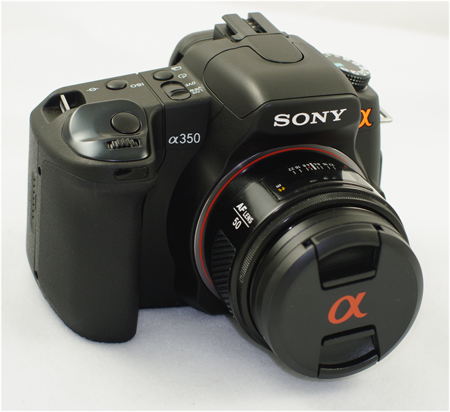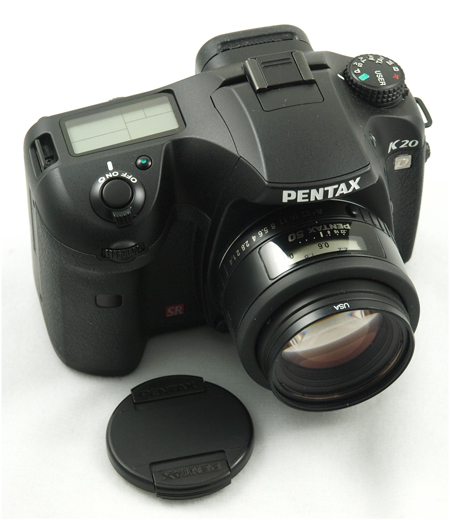Sony A350: Full-Time Live View at 14.2MP
by Wesley Fink on April 3, 2008 3:00 AM EST- Posted in
- Digital Camera
Resolution, Sensitivity and Image Quality
Sony likely wanted to scoop the industry with the 14.2MP resolution of the entry A350. That plan probably got scrapped by the 14.6MP Samsung CMOS sensor used in the prosumer Pentax K20D. While the A350 doesn't gain bragging rights as the highest res sensor south of $8000 it is still mighty close at 14.2MP. It is also the highest resolution sensor to be found in any current or announced entry-level DSLR.
Pentax went to great lengths to emphasize the greater size of their photoreceptor sites that made sensitivity more akin to the Sony/Nikon 12MP sensor. Pentax also emphasized the expanded sensitivity of their 14.6MP sensor with ISO options to 6400. Sony makes no special claims for the 14.2MP sensor in the A350, but the new sensor still has the option of ISOs to 3200.
We've already discussed how the A350 is easy to use with the best Live View you can find in a DSLR these days. The big remaining question, then, is whether the 14.2MP sensor really makes any difference in image quality.

To answer that question we considered that the most revealing test of sensitivity, noise, and resolution is low tungsten light typical of home interiors. The selected scene was not chosen to be pretty but to be revealing of sensitivity, noise, and image quality. It is a shot of my office stacked with motherboards and other review equipment taken with a standard 50mm f1.4 lens.

We found the APS-C 14.6MP CMOS sensor in the Pentax K20D to be excellent in sensitivity with well-controlled noise. The sensor size and resolution is roughly comparable to the A350, but the camera is much more expensive, uses a CMOS sensor rather than CCD, and it is targeted at the prosumer rather than entry-level. For those reasons, we included the Pentax K20D in these comparison tests.

The Canon 5D is justifiably famous for its incredible resolution with the full-frame 12.2MP CMOS sensor. The larger size sensor creates larger photo sites and the larger pixels are more sensitive to light than smaller APS-C sensors. The larger sensor size means the pixel size is more like an 8MP APS-C than a 12.2MP sensor. That makes for a good comparison to these two 14+MP sensors.
All images used a 50mm f1.4 lens (Pentax 50mm f1.4, Sony/Minolta 50mm f1.4, Canon Ultrasonic 50mm f1.4). Aperture Priority was used with a fixed aperture of f4 at all ISOs on all three cameras. Shots were taken using a tripod and remote shutter release to prevent shake. High ISO Noise Reduction used the lowest level of high ISO NR that could be selected in each camera. White Balance was manually set to Tungsten on each camera and the only light source is a 100W tungsten bulb. These harsh test conditions should make image noise as severe as you will likely see in each camera short of time-exposure darkness. Images were captured in JPEG format so they could be displayed and downloaded without the requirement for post-processing software.










113 Comments
View All Comments
steveChance - Tuesday, April 29, 2008 - link
[please disregard this post if this topic has been covered already in the readers' comments as I have not read all twelve pages of them]I find it odd that you would test cameras using printed matter as sample subject. Like digital images printed matter (esp. 4-color process) has its own errors that will (IMHO) negatively effect the photographic results.
Use a loupe to view at the actual item shown in the crops...
jcbenten - Friday, April 25, 2008 - link
Nice article. I presume I have come across this with all the corrections. I look forward to comparisons to the XSi, K200, and A300. I am "attempting" to purchase my first (D)SLR and I continue to out think myself. Your A350 crops came out much better than I anticipated. Maybe there is still life in the CCD.punchkin - Tuesday, April 8, 2008 - link
... before performing another "comparison".cputeq - Wednesday, April 9, 2008 - link
You should also consider the text of the review before making snide comments.The review indicated all camera white balance settings were set to Tungsten. If one camera or another has a warmer look than another, that's the "fault" of the camera.
The issue of the image comparisons was noise, not color accuracy.
Zak - Wednesday, April 9, 2008 - link
I'm not saying the review was bad or good, I can't care less for SONY's cameras, and I don't want to put down your efforts, but I think AnandTech is losing focus. Please return to your roots: computer stuff and leave the camera reviews to other established camera review sites that don't do computer stuff review;) When I come here I want to read about about computer stuff. If I want to read about cameras I go to DP Review, Steve's Cams, Digital Camera Resource, Fred Miranda, The Imaging Reource just to name a few. Honestly, I see at least 50% drop in number of interesting articles on AT. Oh, and the same goes for game reviews. XBox game reviews on AT? Please…Zak
MKFAGAN - Monday, April 7, 2008 - link
I was wondering why everyone is down playing the in camera zoom feature this is huge..The way I see it I have a 50mm 1.4 which is actually a 70mm with the 1.6 crop I press the button to get 1.4x zoom this gives me a 98 1.4 lens I press it again I get 2x zoom so I get a 140mm 1.4 thats huge It is like having 3 prime lenses in 1 so what if I lose a few MP This is big could you imagine a 135mm 2.8 with crop factor 216mm 2.8 press the button to 2x zoom I have a 432mm 2.8 this is a huge featureWesley Fink - Tuesday, April 8, 2008 - link
The auto-teleconverter is convenient, but it is really just a crop of the 14.2 megapixel image. You can do that by croppping images from any digital camera. I was also disappointed that the auto teleconverter does not work in Live View mode.In fact, there is no real zoom mode in Live View to assist in focusing, as I learned the hard way in trying to set critical focus for the resolution/noise crops. The tiny viewfinder and no zoom in LV made accurate manual focusing a real chore. While Sony's Live View is the fastest and most convenient LV we have tested, both the Pentax K20D and Olympus E-3 allow you to select an area to enlarge in LV and then magnify it (7X, 10X) for manual focusing - which does work real-time on both cameras. That made manual focusing MUCH easier for the test series on those two cameras.
haplo602 - Thursday, April 10, 2008 - link
Briliant Wesley ... THIS is that kind of information that should have been in the review !!!That's also what I meant in my earlier post. Camera handling and the little quirks that either get in the way or aid in actual shooting.
Maybe I missed the part in the review, but I do not recall you mentioning the auto-teleconverter. Also the LV limitation on focusing (coupled with the horrible viewfinder) are a critical point that should have been in the review.
retired hiker - Monday, April 7, 2008 - link
I have a problem with the title of your review. Tell me how I can Live View at 14.2MP. Certainly the tiny display on the camera can't give me that resolution.krakman - Saturday, April 5, 2008 - link
also they sell fer around 30$ on amazon.